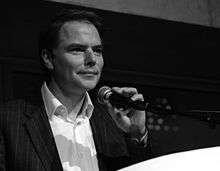Ole Bouman

Ole Bouman (born 1960, Amsterdam is Founding Director of the Shekou Design Museum, an initiative of China Merchants Group and the Victoria and Albert Museum, due to open in 2017 in a building designed by Japanese architect Fumihiko Maki.
Career
Bouman began his career in The Netherlands as art and architecture critic of De Groene Amsterdammer, for which he wrote a weekly column between 1987 and 1997.
In 1994 he published The Invisible in Architecture, a comprehensive and critical overview of contemporary architecture. Co-author was Roemer van Toorn.
In 1996 Bouman curated the Dutch entry to the Triennale di Milano, with an installation that reflected upon the future of architecture in the digital age. He continued by publishing the essay RealSpace in QuickTimes on the effect digital technology will have on the idea of mankind and how it expresses itself in building.
After these publications, Bouman was appointed editor in chief of the international architecture magazine Archis, which lasted until 2004. In 2005 he launched a successor to Archis, called Volume. Contributing editors were Rem Koolhaas and Mark Wigley.
The last issue Bouman edited in 2007, covered his research for the Massachusetts Institute of Technology, presented as an imaginary Studio for Unsolicited Architecture, which pre-empted a new responsibility of architecture to invent its own mandate and market in an age of crisis.
In 1998 Bouman, by invitation of director Chris Dercon, curated an exhibition in the Museum Boijmans van Beuningen called Egotecture, which featured works from the collection depicting 500 years of interaction between space projections and the human self-image.
In 2000 Bouman was one of the curators of Manifesta 3 in Ljubljana. Frustrated with the automatisms that come with an art festival hosted by an emerging city, he produced a parallel exhibition on internet called Virtual Manifesta.
In 2002 Bouman published The battle for Time (Strijd om Tijd), an essay about the ongoing fragmentation of time experience and a call the re-synchronize culture with a series of dramatic interventions.
After running Volume , Bouman became director of the Netherlands Architecture institute (NAi), which he transformed from an expert centre into a civic institution. This effort was exemplified by a major renovation, finished in 2011, as well as the launch of a new activist agenda for the discipline of architecture called Architecture of Consequence. Bouman also launched an alternative collection policy for the NAi as national architecture archive. He left the NAi after the Dutch government enforced a merger with other institutions to become a new national centre of creative industries.
In 2013, Bouman was appointed Creative Director of the Urbanism/Architecture Bi-City Biennale of Shenzhen/Hong Kong, for which he re-developed an industrial plant into a culture facility called “The Value Factory”. For the duration of the Biennale, this Value Factory was occupied by a variety of international cultural institution, such as MoMA, V&A, Maxxi Museum and OMA. Several entries were later re-featured at the Venice Biennale 2014.
After the Biennale he stayed to work in Shenzhen, being appointed the founding director of the new to be established Shekou Design Museum.
References
Ole Bouman named as director of V&A-backed design museum in China
OLE BOUMAN TALKS ABOUT ‘HIS’ SHEKOU DESIGN MUSEUM
interview with ole bouman, curator of the UABB value factory in shenzhen
Ole Bouman was van 2006 t/m 2012 directeur van het Nederlands Architectuurinstituut.
Ole Bouman appointed Creative Director of the 5th UABB*Shenzhen, 2013-4